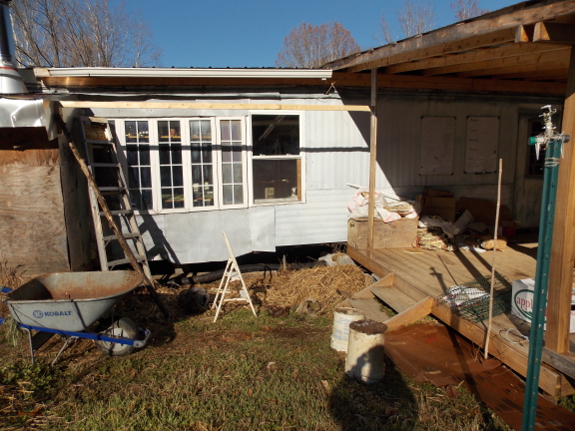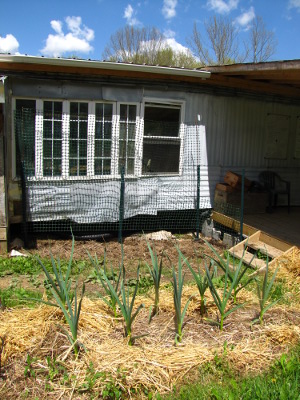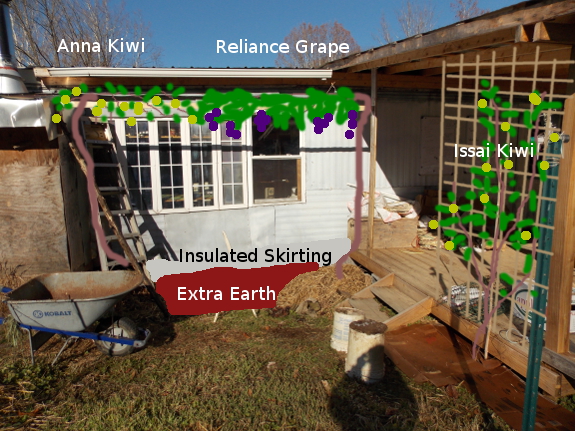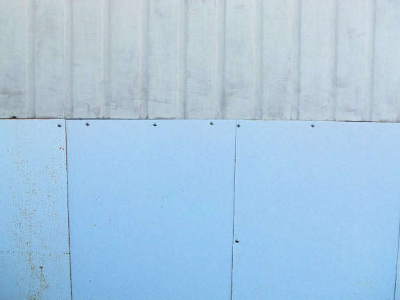
Mitigating trailer temperatures with landscaping and skirting

I mentioned in yesterday's post that The Complete Book of Edible Landscaping got me  thinking
in more depth about what we want to do in front of our bank of
south-facing windows. These windows do a remarkable job of heating
the trailer on sunny winter days, but, unfortunately, they do nearly as
good of a job of heating the trailer on sunny summer
days. In a perfect world, we'd plant a big shade tree here, but
that would block out light to my vegetable garden, so I'm instead using
vines on an arbor to reflect the summer heat while letting in winter
sun.
thinking
in more depth about what we want to do in front of our bank of
south-facing windows. These windows do a remarkable job of heating
the trailer on sunny winter days, but, unfortunately, they do nearly as
good of a job of heating the trailer on sunny summer
days. In a perfect world, we'd plant a big shade tree here, but
that would block out light to my vegetable garden, so I'm instead using
vines on an arbor to reflect the summer heat while letting in winter
sun.
This spring, I tried out version 1.0
using a simple pea trellis and scarlet runner beans (shown to the
right). I'm glad of the experiment because it proved to me that
this area is way too waterlogged to plant directly into the
ground. In preparation for version 2.0, Kayla and I dumped weeds
in front of the trailer all summer, and by November, I had some great
topsoil to shovel up into two mounds, one on each side of the row of
windows.

This picture shows what I
imagine the area will look like in five years if everything goes
according to plan. I've already put in the Issai kiwi (this
summer) and the Reliance grape (last month), and the Anna kiwi will be
arriving this spring. The last two were planted in those mounds I
mentioned, and Mark pointed out that we have some good soil that needs
to be excavated near the goat path, which will allow me to fill in
between the two mounds for later root development. I also plan to
finally install the downspout to channel that area's roof water into the
greywater wetland, and Mark's going to upgrade the trellis he started
to make it strong enough to handle two heavy vines, while also making a
lattice on the edge of the porch for the Issai kiwi. (I think
we'll also make the trellis a little higher since the photos above
illustrate how the current height will still shade the windows quite a
bit in the winter.)
The part I haven't
decided yet doesn't actually have anything to do with the plant life,
although it does relate to trailer temperature modification.
Eventually, we want to skirt the whole trailer, but that's a long-term
project that hasn't made it onto the to-do list yet. In the
meantime, I figured we'd better skirt this one little area now before I
start mounding up earth and planting long-lived perennials. I
found several interesting websites while researching the skirting topic
and discovered that there are at least two schools of thought on how to
moderate the floor temperature of a trailer:
- Use plain skirting around the outsides, then lay down a vapor
barrier on the ground under the trailer with polystyrene foam over
top. This is recommended by the extension service in Alaska.
Related alternatives involve blowing foam insulation into the belly
(area between the frame and ground inside the skirting) or making a
false floor below the frame to hold insulation right up against the
underside of your floor.
- Make your own insulated skirting around the perimeter of the trailer using polystyrene foam attached to treated two-by-fours on the ground and to the bottom of the trailer. This option is usually then covered by traditional skirting or paneling of some kind on the outside. No one talks about this, but it seems like you might get better results if you buried the bottom of the insulated skirting a foot or so into the soil?
 In Trailersteading (free today!), one of our readers
skirted his home with the insulated centers cut out of doors before
installing windows (shown to the right). That sounds like the
optimal skirting material, but I'm afraid we don't have a source
here. Any other ideas or feelings on which of the two skirting
options above makes the most sense?
In Trailersteading (free today!), one of our readers
skirted his home with the insulated centers cut out of doors before
installing windows (shown to the right). That sounds like the
optimal skirting material, but I'm afraid we don't have a source
here. Any other ideas or feelings on which of the two skirting
options above makes the most sense?
Finally, I'm considering the
utility of stones or cinderblocks used as thermal mass in this
area. Hardy kiwis are damaged by late-spring frosts in our area
and grapes tend to succumb to fungal diseases during our wet summers, so
I figure both plants would enjoy some extra heat gained by covering the
ground with stones between their feet. Rosalind Creasy agreed,
noting that a patio in front of the south-facing wall of our house can
even help heat the home by radiating heat during winter nights (assuming
you can shade the stones enough in the summer so they don't bake you
then). Which brings me to question number two --- would I be
better off using cinder blocks instead of traditional skirting in this
one zone of the trailer to provide yet more thermal mass?
Anyone who made it through this long post ---
you deserve a gold star! Here's your bonus --- did you know that
evergreen shrubs and vines up against the north side of a house can act
as exterior insulation, producing a pocket of air that makes your house
stay warmer? And did you know that I'll be able to guess how much
our trellis will shade the windows in the summer by going out at
midnight under a winter full moon --- the moon shadows will mimic sun
shadows six months later. Tips courtesy of Rosalind Creasy.
Want more in-depth information? Browse through our books.
Or explore more posts by date or by subject.
About us: Anna Hess and Mark Hamilton spent over a decade living self-sufficiently in the mountains of Virginia before moving north to start over from scratch in the foothills of Ohio. They've experimented with permaculture, no-till gardening, trailersteading, home-based microbusinesses and much more, writing about their adventures in both blogs and books.
Want to be notified when new comments are posted on this page? Click on the RSS button after you add a comment to subscribe to the comment feed, or simply check the box beside "email replies to me" while writing your comment.

Josef and Gerry --- I considered the awning/overhang option, and would have gone into my thoughts on the topic if the post wasn't already way, way too long. So I'll put them here instead....
So I'll put them here instead....
The overhang is a great idea, but I know from living right inside my south bank of windows that the sun doesn't change its height in the sky precisely in time with the annual change in temperature. Instead, there's a lag period, meaning that even with our little overhang, the sun gets blocked during parts of the early and late winter when I'd like to get that warmth inside the trailer.
Granted, I could make something that I could install and take down when the weather merits, but I tend to let things like that lapse. The great thing about plants is that the leaves instantly disappear after the first hard frost, so I only get the sun-blocking effect when I really want it. Of course, I do have to wait a few years for the vines to get up there, which is the tradeoff.
While I could not do a comparison, I would say cinder blocks would likely be a tremendous asset. My house is stucco and absorbs heat well and tends to be a boon for plants in the spring. In fact, this microclimate generally gives me the equivalent of an extra zone for plants. The only caveat is if an exceptionally deep freeze is coming, some things do need protection if they are budding, but this is easier since the plants are close to the house.
For an overhang, you could consider a pergola for the vines to grow along. The slats allow the sun to still shine through when the vines have not leafed out, but provide shade by the time the sun is at its peak intensity.
Regarding the trellis above the window will this be made of wire or wood? On our pergola we used 2x4's as the top part that would be in your instance perpendicular to your house. The 2x4s were tall enough that they shaded a lot during the morning and evening hours and only allowed the sun to penetrate during a small window at noon. Wires would eliminate this. You will probably have time to change it before the vines make it all the way up but I thought I would mention it. I would bet you will have your vines in place as drawn in 3 years instead of 5.
CMU could be good for this area, but would require some additional time and expense to get it right. The base would have to be pretty solid for them so they don't settle in that area if it's wet at all after you add the downspout. A crushed gravel base could be an option for a footing/foundation for this wall. If you do end up grouting the joints you could put metal strapping in the grout joints with the horizontal reinforcement and attach it to the framing of the trailer so it does not fall over.
CMU's don't have a lot of thermal mass unless you fill the cells solid. If you could use a different skirting system like treated wood and rigid insulation and find a way to stack bricks they would be more dense than a hollow CMU bock. They would be naturally darker too and absorb more heat. Grouting the bricks may not be required if you could put some metal brick ties back to the skirting so the weight of the brick sandwiches the ties. I would put a 10 mil plastic vapor barrier down on the ground and insulate the skirting with 2" rigid insulation and taped seams or even running the vapor barrier up the wall. Then a batt insulation type system that is separated from the plastic on the ground to insulate the floor. This space would have to be sealed well to keep rodents out of your insulation which would be the only advantage that I could see for putting the skirting down into the ground. The space beneath would buffer you from the outside temperatures and keep the moisture low. The 2" insulation would increase the effectiveness of the insulation under the floor. I am not sure how the framing and floor system works for a trailer so I don't know how difficult it would be to insulate the frame/floor structure with batt insulation.
I would not leave the rigid insulation exposed on the outside due to UV and the concern over flammability. With the rigid insulation between some outside material (got any more metal roofing?) and plastic vapor barrier on the inside I would not be concerned about fires occurring in this space.
Sorry, I think my response may have been longer than your blog entry. If any of this is not clear let me know and I will clarify. Hopefully it will at least give you an idea or two to build from.
Heat is transported by three means;
For proper heat retention you need to check and limit all three of them.
Conduction: Generally things that conduct electricity well will also conduct heat well. So you should avoid metal objects going from the inside to the outside of your house. They will act as "cold bridges" sucking heat out of your house.
Convection: In the situation now, the air under the trailer that is warmed up by the floor flows away around the edges and is replaced by cold air. If you were to skirt the trailer completely, that would seal of most of the air flow. So you'd get an enclosed space with a relatively warm top (your floor) and a cold downside (the ground). Since warm air tends to flow up, the situation is not very conductive (if you'll pardon the pun) to heat loss. But if the temperature difference becomes big enough, convection will take place. So skirting will help, but it might not be enough.
Radiation: Even if you skirt the trailer, radiation from your warm floor will still strike the cold surface and be absorbed, leading to heat loss. The best way to combat this is generally to put a reflective foil between your floor and the ground. You can also buy isolation material with a reflective layer on it.
So I would recommend both skirting and an underfloor isolation (with heat reflective layer).
With regard to skirting I don't see any benefit to burying the skirting in the ground, at least not more than necessary to keep the wind and any rodents out.
A couple of points to keep in mind;
@Rena: If you are worried about the flammability of polystyrene (which is a valid concern), you could use e.g. polyurethane foam (look for grades with a non-halogenated fire-retardant like ammoniumpolyphosphate) or mineral wool which is inflammable.
Anna: note that mineral wool will wick up water. One of its uses is as a growth medium in hydrophonics.
Whether cinderblocks will work as a thermal mass depends on their heat capacity related to their heat conduction and their mass related to their surface area. If a stack of cinderblocks sitting on the ground in the winter sun becomes noticeably warmer than the environment, go for it. If not, don't bother.